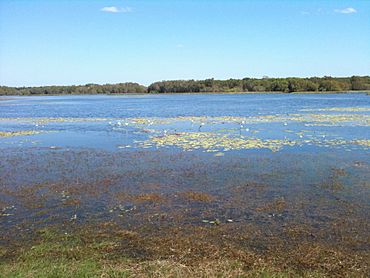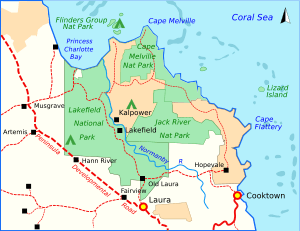Lakefield National Park facts for kids
Quick facts for kids Lakefield National ParkQueensland |
|
|---|---|
|
IUCN Category II (National Park)
|
|

Lakefield National Park, July 2011
|
|
| Nearest town or city | Cooktown |
| Established | 1979 |
| Area | 5,370 km2 (2,073.4 sq mi) |
| Managing authorities | Queensland Parks and Wildlife Service |
| Website | Lakefield National Park |
| See also | Protected areas of Queensland |
Lakefield National Park is a very large national park in Queensland, Australia. It is located on the Cape York Peninsula, about 1,707 km northwest of Brisbane. It is also 340 km north-west of Cairns by road.
This park is huge, covering 5,370 square kilometers (2,073 sq. miles)! This makes it the second largest park in Queensland. It is even bigger than countries like Trinidad and Tobago. Lakefield National Park is a popular spot for fishing and camping.
The park stretches from Princess Charlotte Bay in the north down to the town of Laura. It includes parts of the Normanby River, Morehead River, and North Kennedy River. You can also find many lakes, billabongs (waterholes), and wetlands here. There are over 100 permanent river lagoons in the park.
There is one main unsealed road, called Lakefield Road, that goes through the park. However, this road often becomes impassable during the wet season. Because of this, the park usually closes during the wet season. There is a ranger station inside the park. Rangers can help with information or in emergencies.
Contents
Climate and Seasons
The weather in Lakefield National Park changes a lot throughout the year. From early December to April is the wettest time. During these months, the park gets about 1,200 mm of rain on average. Sometimes, heavy monsoon rains fall. These rains can cause the rivers to flood and overflow their banks.
In the drier months, which are from May to November, the plains of the Laura Basin become very dry and dusty. This is a big contrast to the wet season.
History of the Park
Before Europeans arrived in the 1870s, many Aboriginal groups lived in this fertile coastal area. You can still find Aboriginal cultural heritage sites at places like Hann and Kalpowar crossings.
The first European explorer to travel through this land was Edmund Kennedy. Another early explorer was William Hann. The Laura Homestead was set up around 1892. It is one of the oldest farmhouses still standing in this region.
Lakefield Station was a very large cattle farm. It stretched for over 150 kilometers. In 1960, a new main house was built for the station. The Queensland Government bought several cattle stations, including Lakefield, in 1978. Lakefield National Park was officially created in 1979.
Amazing Animals (Fauna)
Lakefield National Park is home to many different animals. It is especially famous for its waterbirds. You can see birds like the brolga, sarus crane, and black-necked stork. There are also comb-crested jacanas and magpie geese.
In the woodland and grassland areas, you might spot agile wallabies. You could also see northern nailtail wallabies and Australian bustards.
Threatened Species
Some special and rare animals live in the park. These include the golden-shouldered parrot and the star finch. The red goshawk, Lakeland Downs mouse, and spectacled hare-wallaby are also found here. You will see many termite mounds scattered across the park, especially on the Niland Plain.
Reptiles, Amphibians, and Mammals
The park has many reptiles, amphibians, and mammals. Mammals include dingoes, wallabies, and possums. You might also see foxes, wild cattle, and wild pigs. Sometimes, there are so many wild pigs that some need to be removed.
There are many types of snakes in the park. The brown snake, death adder, and the taipan are three very dangerous ones. They are all very venomous. Monitor lizards, also called goannas, are also common. The yellow-spotted monitor is often seen. Many frogs live here too, like the green tree frog.
Crocodiles in the Park
It is very important for visitors to know that there are many crocodiles in the park's waterways. Lakefield National Park has the largest number of crocodiles in Queensland.
There are two types of crocodiles here:
- Freshwater crocodiles: These are generally smaller and less dangerous to humans.
- Saltwater crocodiles: These can grow very large and are potentially dangerous to humans.
Saltwater crocodiles are a protected species in Australia. They seem to be breeding well in the park. Always be very careful near water in Lakefield National Park.
Wonderful Plants (Flora)
The main types of plants in the park are eucalypt woodlands. You will also find gallery forests along the waterways. These are dense forests that grow along rivers and streams.
There are many kinds of eucalypt trees, like bloodwoods and Moreton Bay ash. Wattles are also common, including the northern black wattle. Paperbark trees, such as the weeping paperbark, grow near water.
The Unique Kennedy Palm
One of the most beautiful plants in the park is the Corypha utan palm. These palms usually grow near waterways. They can handle the floods that happen during the wet season.
These palms live for a very long time, sometimes 75 to 100 years. At the end of its life, the palm produces a huge flower stalk. This stalk can be about a meter tall and has millions of flowers! After it flowers and produces seeds, the palm dies. New palms grow well in Lakefield. Locals call this palm the "Kennedy palm" or "Gebang palm."
Closer to the coast, you can also find healthy mangrove ecosystems. There are also salt flats, which are flat areas covered in salt.
Fishing Fun
Lakefield National Park is one of the national parks in Queensland where you can go fishing. Fishing is allowed at all campsites and other places. However, some areas might have cultural restrictions where fishing is not allowed.
In freshwater, you might catch fish like barramundi, tarpon, and catfish. In saltwater areas of the park, you could catch mangrove jack, fingermark, cod, trevally, queenfish, and salmon.
How to Get There (Access)
You can reach Lakefield National Park by road. You can come through Cooktown or Laura. The easiest way is to take the Peninsula Development Road, which is north of Lakefield on the Mulligan Highway.
The Starcke Track is another route. This track is more popular with four-wheel drive vehicles. You can also come from the north, from Coen, via the Musgrave Roadhouse.
The park is in a remote area. Visitors should make sure they have enough food, petrol, and other supplies. Get these before you leave Cooktown, Lakefield, or Laura. Roads in the park might close very quickly after rain. This is to prevent damage to the road surface.
Camping in the Park
There are many bush campgrounds throughout Lakefield National Park. Two camps, Kalpowar Crossing Campground and Hanns Crossing Campground, have toilets and showers. Other campsites across the park do not have these facilities.
You need a permit to camp. Permits are now obtained online or through official channels. Self-registration is no longer possible (as of April 2013). Some campsites allow generators that operate quietly (65 dB or lower).
For your safety, you should not camp within 50 meters of any body of water. This is because of the threat from crocodile attacks.
See also
 In Spanish: Parque nacional Lakefield para niños
In Spanish: Parque nacional Lakefield para niños


